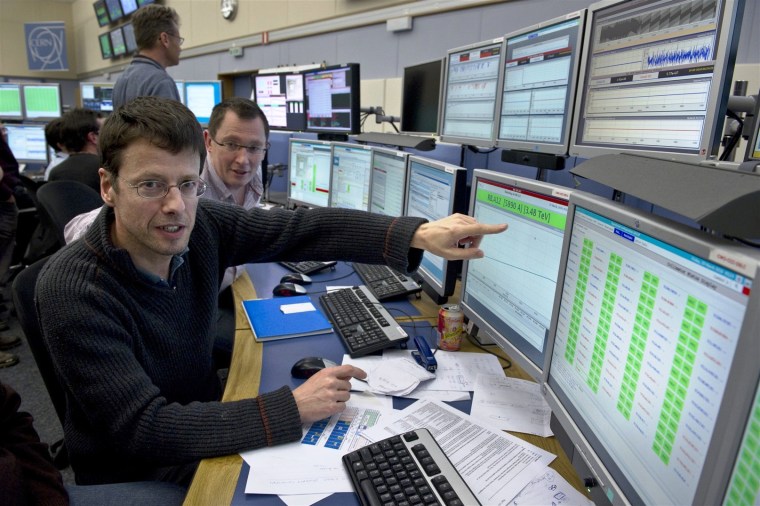Operators of the world's largest atom smasher on Friday ramped up their massive machine to three times the energy ever previously achieved, in the run-up to experiments probing the secrets of the universe.
The European Organization for Nuclear Research, better known by the French acronym CERN, said beams of protons circulated at 3.5 trillion electron volts in both directions around the 17-mile (27-kilometer) tunnel housing the Large Hadron Collider under the Swiss-French border at Geneva.
The next major development is expected in a few days when CERN starts colliding the beams in a new round of research to examine the tiniest particles and forces within the atom, in hopes of finding out more about how matter is made up.
The collider in December had already eclipsed the record of the next most powerful machine, the Tevatron at Fermilab outside Chicago, which has been running just shy of a trillion electron volts, or TeV.
The extra energy in Geneva is expected to reveal even more about the unanswered questions of particle physics, such as the existence of dark energy and matter. Scientists hope also to approach on a tiny scale what happened in the first split seconds after the big bang, which they theorize was the creation of the universe some 14 billion years ago.
CERN has reported a series of successes since the collider was restarted last year after 14 months of repairs and improvements. The repairs were required after a spectacular failure occurred during the initial startup phase in September 2008.
CERN improved the machine during a 2½-month winter shutdown to be able to operate at the higher energy.
"Getting the beams to 3.5 TeV is testimony to the soundness of the LHC's overall design, and the improvements we've made since the breakdown in September 2008," said Steve Myers, CERN's director for accelerators and technology.
CERN Director-General Rolf Heuer revealed that there had been a snag in reaching 3.5 TeV Friday. He said it increased the ramp time to 75 minutes from the expected 15 minutes. Heuer said the problem was in a phenomenon linked to the machine protection systems, but he did not elaborate.
Those protection systems must enable the scientists if they see a problem to switch off the magnets and extract the stored energy in about 10 seconds. At the same time the systems have to be tuned to avoid triggering a beam dump when not technically necessary.
Heuer said he expected the problem to be corrected.
When the collisions start at the new, higher energy, CERN plans to run the collider continuously for 18 to 24 months, much longer than previously.
This is because the machine operates at near absolute zero degrees, colder than the chilliest temperatures in outer space. Shutting off the LHC can require months to bring the equipment up to room temperature for any checks, repairs or improvements, CERN said.
After two years of running the LHC will be shut down for about a year. During that time, specialists will install improvements and make other changes to enable the collider to operate at its design energy of 7 TeV in each direction to produce collisions of 14 TeV.
The Large Hadron Collider was built to examine a wide range of suspected phenomena — including dark matter and "big-bang soup" as well as the interactions of antimatter and matter. The collider's prime quest is the search for the Higgs boson, which scientists theorize gives mass to other particles and thus to other objects and creatures in the universe. The Higgs boson, also known as "the God Particle," is the only fundamental particle predicted by physics' standard model that has not yet been detected.
The LHC was launched with great fanfare on Sept. 10, 2008, but it was sidetracked nine days later when a badly soldered electrical splice overheated and set off a chain of damage to the massive superconducting magnets and other parts of the collider some 300 feet (100 meters) below the ground.
CERN had to undertake a $40 million program of repairs and improvements before it was ready to retry the machine at the end of November. Then the collider performed almost flawlessly, giving scientists valuable data in the four-week run before Christmas.
CERN specialists have checked out and improved electrical connections and other parts throughout the machine.
Before the end-of-year break, the LHC collided two beams of circulating particles at 1.18 trillion electron volts, or TeV, about 20 percent higher than the previous record set at Fermilab. During that December run, each of the LHC's four major experiments, ALICE, ATLAS, CMS and LHCb recorded more than a million particle collisions for scientists around the world to analyze.
This report was supplemented by msnbc.com.
